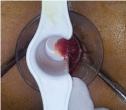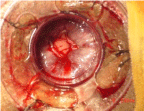Editorial
Minimally Invasive Proctoido-Haemmorrhoidectomy(MIPH) popularized by longo may many a time fall in disrepute because of the errors by man behind the machine or occasionally the machine itself.
Man behind the Machine
Various reasons for committing mistakes by the surgeons can be
Surgeon factor
Inadequate knowledge and experience Overconfidence, wrong patient selection, obesity, faulty position, inadequate anesthesia, inadequate relaxation, improper fixation of Circular Anal Dilator (CAD), purse string at wrong site, purse string may be loose, pull on suture-non uniform, leaving big mucosal islands Figure1-3.

Figure 1:

Figure 2:

Figure 3:
The Machine-Itself
Bleeding from staple line Stapler does not fire, anvil gets stuck, size disparity, doughnuts incomplete, damage to the rectal wall, stretch of internal muscles, resulting in short-term or long-term dysfunction Figure 4.

Figure 4: fig4
Risks
Various risks attributed to MIPH procedure are:
If staple is placed too low it can result in severe chronic pain and incontinence. If staple line placed too high, then it leads to failure to relieve symptoms of hemorrhoids. Hemorrhoids are not removed at times because of technical faults of equipment failure so they may continue to bleed. Pelvic, peri-anal or retroperitoneal sepsis can be quite worrisome in some patients. Recto vaginal fistula is a real risk as at the times of firing the stapler, the posterior wall of vagina may also get stapled along with anterior wall of rectum; hence making it imperative to palpate for free posterior wall of vagina before firing the stapler. Persistent pain and fecal urgency are a real problem at times to deal with on follow up for the reason that most sensitive and important mucosal strip of rectum gets sacrificed which seems to play an important role in fecal continence and sampling. This procedure has started falling into disrepute at many centers all over the globe for this very risk. Strictures after stapling may develop in some patients because of excessive fibrosis or vascular insult. Rectal wall hematomas may be seen in some patients after firing the staplers. Perforation of the rectal wall may occur rarely by the introduction of stapler of by size disparity between rectal lumen and stapler diameter. Death rarely due to massive bleeding from staple line if appropriate supportive and corrective measures are not undertaken at the earliest.
Decreasing the Risk
Some of the corrective measures should always be practiced as mentioned under to decrease the risks:
Pain due to staple line- It is commonly seen when you place your staple line quite low. Always ensure that your staple line is at least 2 cms above the dentate line. Bleeding from staple line- Keeping the stapler fully closed for approximately 30 seconds before firing and approximately 20 seconds after firing creates a tamponade. But the wisdom remains in examining the suture line meticulously after the procedure and suture ligate the bleeders if any. Never leave anything to chance. The incidence of rectal wall hematomas increases by leaving small bleeders unstitched. Pain due to removal of external hemorrhoids and/or skin tags-removal of skin tags is not recommended as it results in greater pain. Wait three to four weeks for shrinkage of skin tags. Most of them will disappear after the surgery. Excision is recommended only if they are symptomatic. Musculature in the doughnut- The rectal wall muscle can come in the doughnut and it can be minimized by careful shallow placement of the pursestring in the mucosa and submucosa only. Bleeding by hard stool on the staple line-Use stool softeners for 7 to 10 days post-operatively always saves the patient from this complication. Thrombosis of external hemorrhoids is sparsely reported. It is likely inherent to the interruption of venous drainage. It usually clears up without any treatment. Anal stenosis is also quite sparsely reported. Staples fall off in three to four weeks, and the healing of mucosa generally takes place in a few days. However, a digital rectal examination in the follow up period will always allow you to address any impending stenosis or stricture at the earliest by regular dilatations. If doughnuts are incomplete, have a relook and stitch the missed part nicely to achieve complete hemostasis. If anvil gets stuck, cut the purse string and redo the whole procedure. If stapler fails to fire, again redo the procedure. It is a must to have an extra stapler always by your side
Remember
This surgery should preferably be avoided in following conditions:
MIPH for fourth-degree piles- It should be avoided as it gives a higher complication rate and worse results. Enterocele and anismus are contraindications to MIPH and STARR procedures and both operations should be used with caution in patients with weak sphincters, Fissures, Previous prostate radiation, Acute thrombosed internal hemorrhoids, Previous rectal surgery (scarring may cause difficulties in various stages).
Evidence
7 RCT-537 participants; found that stapled hemorhoidectomy patients have more recurrent hemorrhoids than surgical groups. Out of 269 stapled group, 23 had recurrences, compared with 4 among 268 patients in the surgical group. Stapling subjects complained of prolapse in significantly higher proportion of both within 12 months and longer [1]. However in stapled group results were better in terms of less pain, itching or bowel-movement urgency; however, these were data “trends” that did not reach the level of significance. All other clinical outcomes favored excisional surgery. “Conventional excisional surgery remains the ‘gold standard’ in the surgical treatment of internal hemorrhoids”. In a Cochrane meta-analysis of RCTs patients who underwent PPH were significantly more likely to have recurrent hemorrhoids in long-term follow-up at all time points than those who underwent CH (12 trials, 955 patients; Odds Ratio (OR), 3.22; Confidence Interval (CI), 1.59-6.51; P = 0.001 [1]. 27 randomized controlled trials reported in a systemic review based on comparison of conventional hemorrhoidectomy with stapled hemorrhoidopexy report less pain, shorter operative time, and quicker patient’s recovery of patient, but a significantly higher rate of prolapse and reintervention for prolapsed for the later group [2]. The latest meta-analysis comparing surgical outcomes between stapled hemorrhoidopexy and Ligasure hemorrhoidectomy in 2013 revealed comparable results - with a slightly favorable immediate postoperative results and technical advantages for later group [3]. In view of recent studies, stapled hemorrhoidopexy did not offer any significant advantages over Ligasure hemorrhoidectomy [3]. Besides, stapled surgery is a relatively expensive operation and may cause serious postoperative complications like rectal stricture and rectal perforation [4] as well as severe chronic anal pain [5]. This surgery should be reserved for circumferential prolapsing hemorrhoids and it must be performed by a well-trained surgeon [6].
Take Home Message
We shall guide the technology rather than vice versa. Man behind the machine should be skilled. We cannot afford misfires because of the cost factor. Master the craft before actually starting the craft. Never say no to learning, you will be an underachiever. Be technology friendly or get outdated. Evidence from RCT and Cocharane reviews should guide us. A Fool with a tool continues to be a Fool.
References
- Jayaraman S Colquhoun PH, Malthaner RA. Stapled versus conventional surgery for hemorrhoids. The Cochrane Database of Systematic Reviews. 2006; 4.
- Burch J, Epstein D, Sari AB, Weatherly H, Jayne D, Fox D, et al. Stapled haemorrhoidopexy for the treatment of haemorrhoids: a systematic review. Colorectal Dis. 2009; 11: 233-243 .
- Yang J, Cui PJ, Han HZ, Tong DN. Meta-analysis of stapled hemorrhoidopexy vs LigaSure hemorrhoidectomy. World J Gastroenterol. 2013; 19: 4799-4807.
- Faucheron JL, Voirin D, Abba J. Rectal perforation with life-threatening peritonitis following stapled haemorrhoidopexy. Br J Surg. 2012; 99: 746-753.
- Ielpo B, Venditti D, Balassone V, Favetta U, Buonomo O, Petrella G. Proctalgia as a late complication of stapled hemorrhoidectomy. Report of our case series. Int J Surg. 2010; 8: 648-652.
- Lohsiriwat V. Hemorrhoids: from basic pathophysiology to clinical management. World J Gastroenterol. 2012; 18: 2009-2017.
